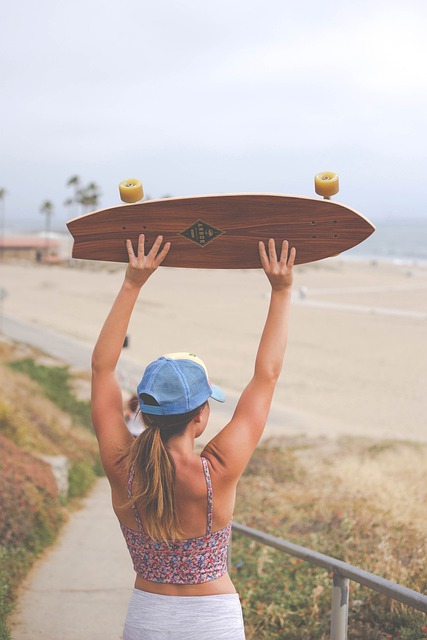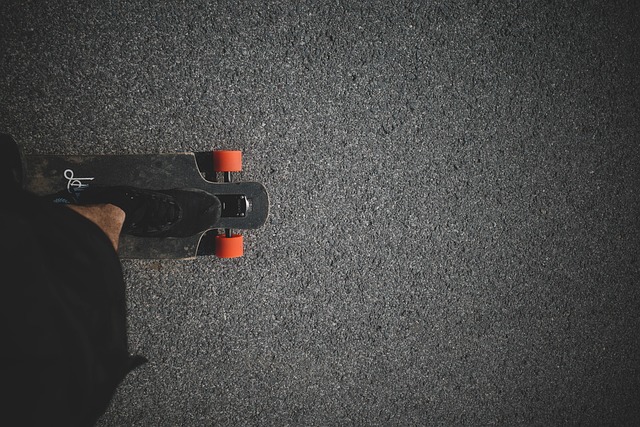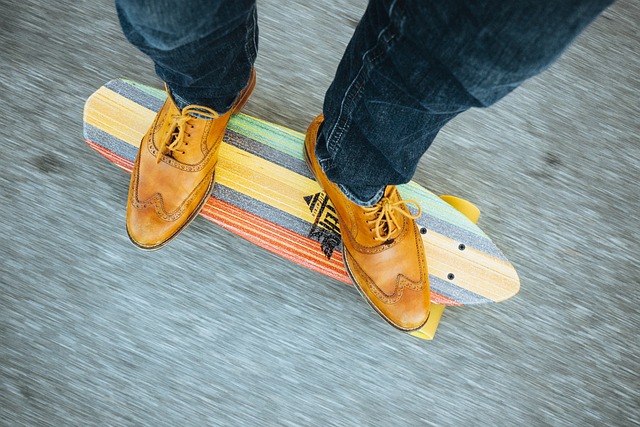Longboards designed for beginners offer a smooth and stable ride with deck lengths from 32 to 40 inches, ideal for balancing. Soft wheels absorb bumps, while drop-down deck designs lower the rider's center of gravity for easier speed control. Beginners should choose boards based on their desired style: longer boards for high-speed stability or shorter ones for agility. Safety gear is essential, and practice in safe spaces helps build confidence before hitting the streets.
Are you ready to explore the thrilling world of longboarding? This comprehensive guide is tailored for beginners seeking an easy-to-follow journey into this exhilarating sport. Discover the benefits and various types of longboards, learn key selection factors, and master essential skills from balance to turning. With safety tips included, get ready to glide effortlessly onto your first longboard adventure!
What is a Longboard for Beginners?

A longboard for beginners is a specialized board designed to facilitate easy balancing and smooth gliding, making it an ideal choice for newcomers to the world of longboarding. These boards typically feature a longer deck, usually between 32 to 40 inches, which provides more stability and allows riders to maintain their balance with less effort. The extra length also enables a more relaxed stance, reducing the risk of fatigue during extended rides.
Longboards for beginners often come equipped with soft wheels that offer a smoother ride over rough surfaces, such as cracks in the pavement or small bumps on the sidewalk. This feature is particularly beneficial for those new to longboarding, as it helps them focus on mastering basic techniques like carving and turning without having to worry about dealing with harsher terrain. Additionally, many beginner-friendly longboards have a drop-down deck design, which lowers the rider’s center of gravity, further enhancing stability and making it easier to pick up speed.
Why Choose a Longboard? Benefits and Advantages

Choosing a longboard for beginners is an excellent way to embark on your balancing journey. Longboards offer several benefits and advantages that make them ideal for those new to this activity. One of the primary advantages is their stability—longboards provide a larger surface area to distribute your weight, making it easier to maintain balance and ensuring a more comfortable and controlled ride. This stability is particularly beneficial for beginners who might feel more confident cruising along without worrying about toppling over.
Additionally, longboards are designed for smooth and efficient turning, allowing you to navigate turns with ease. Their flexible construction absorbs bumps and vibrations from the road, providing a smoother ride compared to shorter boards. This feature not only enhances your overall experience but also makes it less strenuous on your body, making it an excellent choice for recreational riding or commuting. With their versatility, longboards enable beginners to explore various styles of boarding, from cruising and carving to downhill racing, fostering a sense of exploration and progression in this exciting sport.
Types of Longboards: Finding the Right Fit

When choosing a longboard for beginners, it’s essential to consider the various types available to find the right fit for your skill level and desired riding style. One popular option is the classic cruiser board, which typically has a flexible deck, making it easy to balance and maneuver. These boards are great for casual rides around town or along coastal paths.
For those looking to learn tricks and navigate more challenging terrain, a drop-through longboard may be the ideal choice. This design features a lower deck, providing better control and stability while carving and dancing on the board. With a range of sizes and shapes, beginners can find a drop-through that suits their comfort level and helps them progress in their longboarding journey.
How to Select Your First Longboard: Key Factors

When selecting your first longboard, several key factors should guide your decision. Firstly, consider your primary goal: are you a beginner looking for an easy-to-ride board for cruising and casual rides, or do you plan to perform tricks and navigate downhill? This will dictate the type of longboard that best suits your needs.
The size of the longboard is another crucial consideration. Longer boards generally offer more stability at higher speeds, while shorter ones are more agile and easier to turn. For beginners, a board between 36 to 42 inches (91 to 107 cm) in length is often recommended as it strikes a balance between stability and manoeuvrability. Choose a deck shape that aligns with your riding style: drop-through decks provide lower riding position and better control, while top-mount designs offer more flexibility for foot placement. Don’t forget to consider the wheel size; larger wheels enhance speed and smoothness, while smaller ones provide better agility and control on rough terrain.
Setting Up Your Longboard: A Step-by-Step Guide

To start your journey on a longboard for beginners, follow these simple steps to set up your board:
1. Choose Your Board: Select a longboard suited to your style and skill level. For beginners, opt for a flexible board that’s easier to balance and control.
2. Adjust the Trucks: Ensure your trucks are correctly aligned and tightened. This affects both the ride quality and stability. Loosen the set screws on each truck and adjust them until they feel secure but not overly tight.
3. Tune Your Bearings: Spin the wheels to ensure smooth rotation. You can lubricate the bearings for better performance, but be careful not to overdo it – a light application is usually sufficient.
4. Set Up the Deck: Check that your deck has no warping or damage. Place your feet on the board and adjust your stance until you feel comfortable balancing. Some decks may have specific recommendations for foot placement.
5. Install Wheels and Sticks (if applicable): Mount your wheels securely, ensuring they are aligned correctly for smooth rolling. For boards with built-in pusher sticks, attach them firmly according to the manufacturer’s instructions.
6. Final Adjustments: Check all hardware again to make sure everything is tight. Take a few practice runs around your yard or a safe, flat space to get a feel for the board before hitting the streets.
Basic Stance and Balance: Tips for Beginners

Maintaining balance is the cornerstone of longboard riding for beginners. Starting with a basic stance is key; position your feet comfortably apart, with one foot slightly in front of the other, and ensure your knees are bent to absorb shocks. Keep your upper body relaxed, arms extended, and eyes focused on the horizon. Practice this stance while stationary to get a feel for it before attempting to glide.
Balance is all about stability and control. When you start rolling, maintain that relaxed posture, keeping your weight evenly distributed across both feet. Look ahead rather than down at your feet to help keep your balance. Remember, it’s natural to wobble at first; the more you practice, the steadier you’ll become.
Learning to Push and Glide: Techniques for Smooth Riding

Learning to push and glide is a fundamental skill for any longboarder, especially beginners. This technique allows you to smoothly control your speed and direction while minimizing effort. When starting out, focus on finding the right balance between pushing hard enough to gain momentum and gliding with ease to conserve energy.
Practice on flat surfaces first, learning to gauge the ideal speed and timing for pushing. Gradually increase your speed as you become more comfortable. The key is to maintain a steady pace, using your feet to push off in short bursts while allowing the longboard’s wheels to glide smoothly between each push. This coordination will enable you to navigate turns and obstacles with grace and control.
Turning and Carving: Mastering the Art of Maneuvering

Safety First: Essential Tips for New Longboarders

Before you hit the streets on your new longboard, safety should be your top priority. As a beginner, learning to longboard can be both exciting and intimidating. Remember, falling is part of the learning process, but taking precautions can significantly reduce the risk of injury. Always wear protective gear, including a helmet that fits well and meets industry standards, knee and elbow pads, and wrist guards. Choose a board suitable for your height and skill level, and consider starting on a quieter street or in an open park to gain confidence and practice basic maneuvers safely. Remember to stay alert, be aware of your surroundings, and obey traffic laws.
